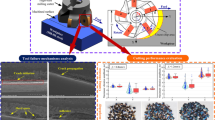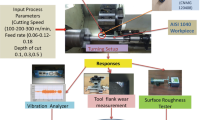Abstract
The present work is a contribution to developing a strategy for rapid analysis of the behaviour of surface roughness and tool wear during machining hardened steel with carbide cemented cutting tools on conventional cutting machines. In agreement with dies and mould manufacturers in East Algeria, the strategy is based on the machining potential of the manufacturers, cutting tools manufacturer’s guidelines and recommendations from literature. The agreement suggested to focus on up and down shoulder finish milling of hardened AISI D3 tool steel using GC1030 insert on a conventional vertical milling machine. The strategy has been developed within five successive steps starting from the analyses of the performance of a machine tool to the definition of an experimental plan to respect. As expected, results show that down shoulder milling is the most suitable process rather than up shoulder milling which must be avoided whatever the hardening condition. In addition, the best performance of down shoulder milling is obtained when machining unhardened steel. In the as-received condition (31.6 HRc) when using down milling the cutting speed can be increased up to the maximum value of 113 m/min, however, the tool life obtained for this value is three times lower than that at Vc = 59 m/min. In 49 HRc hardening condition, milling at Vc = 59 m/min resulted in the good surface finish but with a tool life 6.5 times lower than the tool life when milling in the as-received condition. Vibration measurements provide a time referential data on the evolution of surface roughness together with corresponding tool wear. A time referential data on the evolution of displacement together with the corresponding tool life has been proposed as useful information to meet the needs of dies and moulds manufacturers when milling hardened steels.








Similar content being viewed by others
References
Campi F, Favi C, Mandolini M, Germani M (2019) Using design geometrical features to develop an analytical cost estimation method for axisymmetric components in open-die forging. Procedia CIRP 84:656–661. https://doi.org/10.1016/j.procir.2019.04.324
Favi C, Germani M, Mandolini M (2017) Analytical cost estimation model in high pressure die casting. Procedia Manuf 11:526–535. https://doi.org/10.1016/j.promfg.2017.07.146
Bayramoglu M, Polat H, Geren N (2008) Cost and performance evaluation of different surface treated dies for hot forging process. J Mater Process Technol 205:394–403. https://doi.org/10.1016/j.jmatprotec.2007.11.256
Bendjoudi Y, Becker E, Bigot R, Amirat A (2017) Contribution in the evaluation of a performance index of hot forging dies. Int J Adv Manuf Technol 88:1187–1201. https://doi.org/10.1007/s00170-016-8829-4
Gavalas E, Rossbach A, Feuerhack A (2020) Performance analysis of laser-treated hot forging dies with WC-Co-Cr. Int J Adv Manuf Technol 106:1327–1336. https://doi.org/10.1007/s00170-019-04710-1
Huang W, Zhao J, Niu J, Wang G, Cheng R (2018) Comparison in surface integrity and fatigue performance for hardened steel ball-end milled with different milling speeds. Procedia CIRP 71:267–271. https://doi.org/10.1016/j.procir.2018.05.059
da Costa Castanhera I, Diniz AE (2016) High speed milling of hardened steel convex surface. 44th Proceedings of the North American Manufacturing Research Institution of SME. Procedia Manuf 5:220–231. https://doi.org/10.1016/j.promfg.2016.08.020
da Costa Castanhera I, Diniz AE, Button ST (2020) Effects of tool path strategies and thermochemical treatments on the surface roughness of hardened punches for hot stamping. J Braz Soc Mech Sci Eng 42:214. https://doi.org/10.1007/s40430-020-02306-5
Lauro CH, Filho LSMR, Baldo D, Cerqueira SAADG, Brandão LC (2016) Optimization of micro milling of hardened steel with different grain sizes using multi-objective evolutionary algorithm. Measurement 85:88–99. https://doi.org/10.1016/j.measurement.2016.02.011
Sahoo P, Pratap T, Patra K, Dyakonov AA (2018) Size effects in micro end-milling of hardened P-20 steel. IConAMMA_2017. Mater Today Proc 5:23726–23732. https://doi.org/10.1016/j.matpr.2018.10.163
Stolorz M, Behrens B, Silipigni A, Torriani C (2012) Influence of hard milling on the surface integrity of hot working steel. BHM 157:420–426. https://doi.org/10.1007/s00501-012-0041-8
Suresh R, Basavarajappa S, Gaitonde VN, Samuel GL, Davim JP (2013) State-of-the-art research in machinability of hardened steels. Proc Inst Mech Eng B J Eng Manuf 227:191–209. https://doi.org/10.1177/0954405412464589
Li B, Zhang S, Zhang Q, Li L (2019) Simulated and experimental analysis on serrated chip formation for hard milling process. J Manuf Process 44:337–348. https://doi.org/10.1016/j.jmapro.2019.06.018
Zhang Q, Zhang S, Li J (2017) Three dimensional finite element simulation of cutting forces and cutting temperature in hard milling of AISI H13 steel. 45th SME North American Manufacturing Research Conference, NAMRC 45, LA, USA. Procedia Manuf 10:37–47. https://doi.org/10.1016/j.promfg.2017.07.018
Cui X, Zhao J, Dong Y (2013) The effects of cutting parameters on tool life and wear mechanisms of CBN tool in high-speed face milling of hardened steel. Int J Adv Manuf Technol 66:955–964. https://doi.org/10.1007/s00170-012-4380-0
Cui X, Zhao J (2014) Cutting performance of coated carbide tools in high-speed face milling of AISI H13 hardened steel. Int J Adv Manuf Technol 71:1811–1824. https://doi.org/10.1007/s00170-014-5611-3
Filho MS, Stipkovic MA, Bordinassi ÉC, Delijaicov S, de Almeida SLR (2017) Experimental numerical model of roughness in finishing face milling of AISI 4140 hardened steel. In: Öchsner A, Altenbach H (eds) Improved performance of materials, advanced structured materials, vol 72, pp 83–91. https://doi.org/10.1007/978-3-319-59590-0_8
Gong F, Zhao J, Ni X, Liu C, Sun J, Zhang Q (2019) Wear and breakage of coated carbide tool in milling of H13 steel and SKD11 hardened steel. SN Appl Sci 1:1111. https://doi.org/10.1007/s42452-019-1152-6
Prasath V, Krishnaraj V, Kanchana J, Priyadharshini BG (2018) Tool wear behavior in milling of hardened custom 465 steel. Advances in forming machining and automation. In: Shunmugam MS, Kanthababu M (eds) Proceedings of AIMTDR, pp 517–525. https://doi.org/10.1007/978-981-32-9417-2_43
Wojciechowski S, Twardowski P (2012) Tool life and process dynamics in high speed ball end milling of hardened steel. 5th CIRP Conference on High Performance Cutting. Procedia CIRP 1:289–294. https://doi.org/10.1016/j.procir.2012.04.052
Krajinovic I, Daves W, Tkadletz M, Teppernegg T, Klünsner T, Schalk N, Mitterer C, Tritremmel C, Ecker W, Czettl C (2016) Finite element study of the influence of hard coatings on hard metal tool loading during milling. Surf Coat Technol 304:134–141. https://doi.org/10.1016/j.surfcoat.2016.06.041
Toh CK (2006) Cutter path strategies in high speed rough milling of hardened steel. Mater Des 27:107–114. https://doi.org/10.1016/j.matdes.2004.09.021
Kar BC, Panda A, Kumar R, Sahoo AK, Mishra RR (2020) Research trends in high speed milling of metal alloys: a short review. Materials Today Proc 26(2):2657–2662. https://doi.org/10.1016/j.matpr.2020.02.559
Bouchareb A, Lagred A, Amirat A (2019) Effect of the interaction between depth of cut and height-to-width ratio of a workpiece on vibration amplitude during face milling of C45 steel. Int J Adv Manuf Technol 104:1221–1227. https://doi.org/10.1007/s00170-019-03944-3
Kursuncu B, Caliskan H, Guven SY, Panjan P (2018) Improvement of cutting performance of carbide cutting tools in milling of the Inconel 718 superalloy using multilayer nanocomposite hard coating and cryogenic heat treatment. Int J Adv Manuf Technol 97:467–479. https://doi.org/10.1007/s00170-018-1931-z
Hoseiny H, Caballero FG, M’saoubi R, Hogman B, Weidow J, Andren H (2015) The influence of heat treatment on the microstructure and machinability of a prehardened mold steel. Metall Mater Trans A 46:2157–2171. https://doi.org/10.1007/s11661-015-2789-4
Acknowledgements
The present research work has been conducted within the perspectives of the Tempus MasTech Project: Flexible Modular Master Programme in Technology: Code - 511277-TEMPUS-1-2010-1-DE-TEMPUS-JPCR. The authors would like to thank the company of Forge de l’Est of Ferrovial in Annaba, Algeria, and the company of manufacturing of farm tractors (ETRAG) in Constantine, Algeria, for their useful collaboration and fructuous discussion.
Funding
Financial supports are due to the national research project DGRSDT Algeria, code CSCU232010, and the training university research projects code PRFU A11N01UN230120130011and PRFU: A11N01UN230120190007.
Author information
Authors and Affiliations
Corresponding author
Additional information
Publisher’s note
Springer Nature remains neutral with regard to jurisdictional claims in published maps and institutional affiliations.
Rights and permissions
About this article
Cite this article
Zahaf, M.Z., Benghersallah, M. & Amirat, A. Contribution in developing a rapid strategy in assessing hardened steel machining. Int J Adv Manuf Technol 111, 525–535 (2020). https://doi.org/10.1007/s00170-020-06122-y
Received:
Accepted:
Published:
Issue Date:
DOI: https://doi.org/10.1007/s00170-020-06122-y




